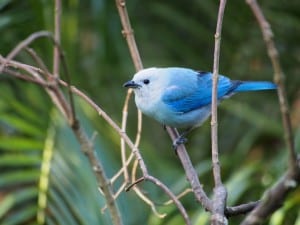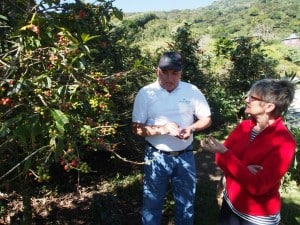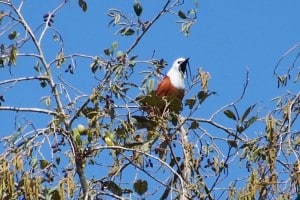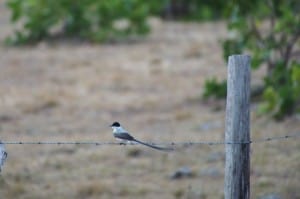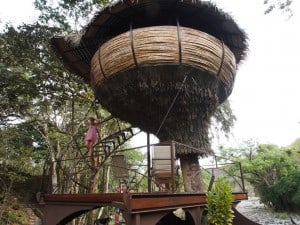You cannot go far in Boquete without noticing the bird activity. Rufous-collared Sparrows, House Wrens and Clay-coloured Robins pour out their songs from gardens and rooftops; pairs of Blue-gray Tanagers fly in unison from tree to tree; Rufous-tailed Hummingbirds buzz about at spectacular Hibiscus and Bougainvillea bushes; Blue-crowned Motmots glean food from roadsides; while Tropical Kingbirds sit nonchalantly on overhead wires, showing no fear of passers-by. A glance skyward will usually be rewarded by the sight of Blue-and-white Swallows, Gray-breasted Martins or maybe even a Swallow-tailed Kite or Broad-winged Hawk.
As I described in my column of November 12, my wife and I had the pleasure this past March of spending five weeks in Boquete, Panama, located in the western highlands near the Costa Rica border. It is one of the most alluring destinations in Latin America for walking, hiking, rafting, birding and all manner of cultural explorations. A trip here isn’t complete without visiting one of the many coffee plantations. In fact, Panama’s coffee is now considered the finest in the world. We decided to visit Finca Lerida, located just 6 km out of town. Not only did we learn first-hand about coffee production, but the tour also included roasting and tasting. The role of the Ngöbe Buglé indigenous people, who hand pick the red berries, was also explained. Ngöbe Buglé women, clad in colourful, ankle-length dresses and always with several children in tow, are a constant presence in Boquete.
The extensive grounds, gardens, flowering hedges and forest trails at Finca Lerida make it one of the premier birding spots in Panama. Hundreds of species are present, many of which feed and nest among the shade-grown coffee bushes. After the coffee tour, I returned the next morning for a half-day of birding with one of Boquete’s most experienced guides, Cesar Cabellero. Thanks largely to his ability to find birds based on their songs and calls, we had great looks at dozens of species. Some highlights included the hyperactive Golden-crowned Warbler, the exotic Long-tailed Silky Flycatcher, the surprisingly tame Chestnut-capped Brush-finch, and the iconic Resplendent Quetzal. As we walked along trails through the ancient trees, the resonant calls of the Three-wattled Bellbird and the ethereal fluting notes of Black-faced Solitaires were a constant presence. The gardens and hedges were alive with 10 or more species of hummingbirds like the Scintillant, the Green Violet-ear and the White-throated Mountain-gem. Cesar also had an encyclopedic knowledge of the numerous tree species at Lerida and what birds are associated with what trees. For instance, the guaba (Inga edulis) attracts White-lined Tanagers, the croton is popular with parakeets, and chusquea, a type of bamboo, is the place to find Peg-billed and Large-footed finches.
Las Lajas
One of the advantages of staying in Boquete is that you are only an hour or two from beautiful beaches on the Pacific coast. One of the longest and most attractive is Playa Las Lajas, located about 70 km east of the city of David. The huge trees lining the road that leads from the Interamericana highway to the beach form a beautiful canopy. Cattle graze in the fields and birds are everywhere. We stopped several times to admire the landscape and add species such as Fork-tailed Flycatcher and Giant Cowbird to our list. The best birding at Las Lajas, however, is at a large lagoon, which offers up all kinds of waterbirds and shorebirds. Black-necked Stilt, Willet, Whimbrel, Ruddy Turnstone and Wood Stork were just a few of the birds we found there. There are also mangrove forests to be explored. A good selection of accommodation can be found in the area, ranging from beautiful bed and breakfasts like Casa Tao where we stayed to the relaxing Las Lajas Beach Resort.
Rio Encantado
Because misty rains and high winds (called “bajareque” in Spanish) are sometimes an issue in Boquete, we decided to hop in our car one morning and drive 20 minutes south to a private nature reserve called Rio Encantado. Not only is it much warmer here, but the lower elevation means the mix of birds is quite different, too. Although we only purchased a day pass, Rio Encantado also offers comfortable accommodation, the highlight being an amazing tree house.The owner, Frank Stegmeier, has planted exquisite gardens and reforested much of the 100 hectares, which border both sides of the Caldera River. An hour’s walk along some of the trails produced birds such as Ringed Kingfisher, Cocoa Woodcreeper, Crimson-backed Tanager, and the lovely Lance-tailed Manakin – a species that sings constantly.
Birding Community
Boquete has an active ex-pat birding group, which organizes regular outings, both in town and beyond. I was able to join the group for some “backyard birding” and for a half-day excursion to a private property belonging to Linda Scott. Like Rio Encantado, Linda and her husband have reforested much of the land and created a veritable nature paradise. I could have spent the entire morning just sitting on her deck! The parade of birds coming to the feeder, gardens and birdbath was non-stop. It included everything from Purple-crowned Fairy hummingbirds to Rufous-capped Warblers. In the trees behind the house, Lineated Woodpeckers and Brown-throated Parakeets called loudly, while Roadside and Gray-lined Hawks soared overhead. Later, as we walked along the trails, a host of different tanagers – maybe my favorite group of tropical birds – provided constant entertainment. The stars were the aptly named Speckled Tanager and the multi-coloured Bay-headed. Had we arrived a minute or two earlier, we would also have seen a rare Sunbittern walking slowly along the forested stream that runs through the property.
Whenever I travel, I make a point of asking the local people whether they are noticing any changes in the climate. People in Boquete told me that it is no longer necessary to wear a jacket to work outside – something that used to be the case – and that the winds are stronger than ever. The heat along the Pacific coast is also much more intense than in the past. I also sensed that Panama still lags behind countries like Costa Rica when it comes to what tourists – and especially eco-tourists – want. As Frank Stegmeier of Rio Encantado pointed out, “North Americans aren’t coming here for the architecture or to see ancient ruins. The government needs to understand that tourists want high-quality experiences with nature. If development continues on its current trajectory and if farmers are allowed to burn their land the way they are doing right now, the country’s reputation as a nature destination will only decrease.” I hope that the Panamanian government will take Frank’s words to heart and provide greater protection to what is still a remarkably beautiful and nature-rich country.
